Shortly after posting on my lone Lophophora alberto-vojtechii seedling I was contacted by Jacopo who is also growing L. alberto-vojtechii. Jacopo started his seeds in three different batches and had germination rates ranging from 10% (like mine) to 45%; several plants were lost to fungal infections and algae, including a variegated L. alberto-vojtechii seedling, so Jacopo decided to graft some of the plants on Selenicereus grandiflorus stock for safekeeping. Below you can find a few pictures of his plants – all photos in this post are courtesy of Jacopo Simonetto, Valencia, Spain.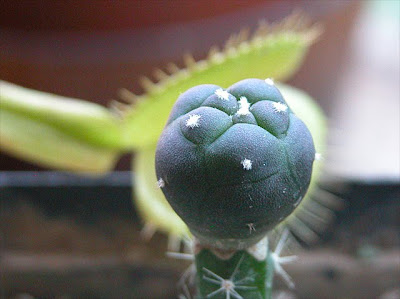
Lophophora alberto-vojtechii grafted on Selenicereus grandiflorus
Jacopo has five L. alberto-vojtechii plants in total – 3 grafted on Selenicereus grandiflorus stock plants and 2 on their own roots. He hopes that his two largest plants reach flowering size this summer (they are already 1 and 1.5 cm in diameter) so he can test the germination rate of verifiable fresh seeds ;-)
Two Lophophora alberto-vojtechii seedlings grafted on Selenicereus grandiflorus stock plants
As an aside, I really like the carnivorous plants in the pictures – especially the Dionaea muscipula (Venus Flytrap) in the first photo that seems just about ready to gulp down the defenseless Lophophora alberto-vojtechii seedling ;-) Also, the Drosera (Sundew) in the second image reminded me that I need to get a few of these plants to help me control the fungus gnats that are having a feast in some of my (non-cactus) plants. 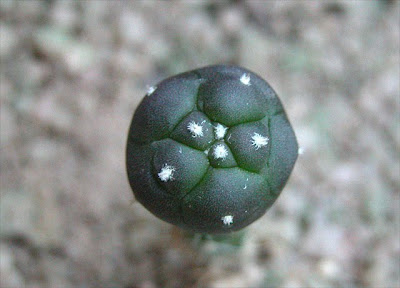
Grafted Lophophora alberto-vojtechii, top view
Jacopo’s plants were started from seed 4-5 months ago and the grafts are 3 months old at the time of writing. I hope to be able to follow the plants as they (with a bit of luck ;-) flower and set fruits in the near future.
For comparison a picture is included below showing one of the seedlings still growing on its own roots – it’s relatively small but Jacopo told me that he grafted the biggest seedlings.
Lophophora alberto-vojtechii seedling
Sunday, July 04, 2010
Lophophora alberto-vojtechii grafted on Selenicereus grandiflorus stock
Wednesday, April 28, 2010
The power of grafting – 6th anniversary
A week ago my grafted Lophophora williamsii (SB 854; Starr Co, Texas) celebrated its 6th anniversary sitting on top a sturdy Trichocereus pachanoi stock. The plant was grafted as a tiny seedling and in 6 years the main head has grown to a width of approximately 8 cm (~3.2'') – the 3 largest offshoots are 6 cm (~2.4'') wide each. The main head seems to have stabilized at 8 ribs while the largest pups are in transition from 5 to 8 ribs.

Lophophora williamsii graft, top view
The last couple of weeks the plant has “popped out” fruits resulting from last years late flowers. This season’s first flower appeared a couple of days ago and was promptly (self-)pollinated – according to previous experience this should result in another fruit in 7-8 weeks time.

Grafted Lophophora williamsii, first flower of the season
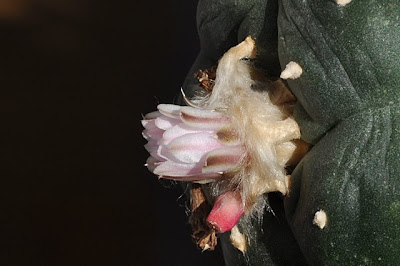
Lophophora williamsii flower and fruit
I’ve already harvested more than 120 seeds from this plant alone this season. As this variety of Lophophora williamsii is not particularly frost hardy I’m not sure if I’ll start all these seeds as the seedlings will have to go to my coldhouse – maybe I should set up a “swap shop” instead ;-)

Lophophora williamsii fruits
I’m wondering for how long the Trichocereus pachanoi stock will be able to support the rather large Lophophora williamsii scion. This is my oldest graft so I have no experience to rely on regarding the actual longevity of Trichocereus stock plants; I guess time will tell.

Lophophora williamsii grafted on Trichocereus pachanoi stock
For comparison you can check the posts on the same graft as one, two, three, four, and five years old.
Sunday, November 08, 2009
Lophophora williamsii f. cristata (crested / fasciated peyote cactus)

Lophophora williamsii f. cristata, top view
Last Sunday I went on a shopping spree and ordered some Lophophora alberto-vojtechii seeds from Köhres and a Lophophora williamsii f. cristata plant from Cactus Plaza.

Crested Lophophora williamsii, front view
The crested L. williamsii arrived yesterday without a scratch and looks exactly as advertised with a length of 4.2 cm and grafted on a Trichocereus pachanoi stock; the width of the crest is 2.5 cm.

Lophophora williamsii f. cristata, side view
I have never grown fasciated Lophophora before and look forward to follow the plant in the years to come. I'm particularly curious to see if the fasciation also affects the flowers or if they develop normally.

Fasciated Lophophora williamsii, the other front
I'm happy as can be with my new acquisition while “She Who Must Be Obeyed” gently shakes her head in silent disbelief ;-)

Crested Lophophora williamsii grafted on Trichocereus pachanoi stock
Tuesday, November 03, 2009
Lophophora williamsii v. caespitosa graft – 5th anniversary
I'm sad to say that I have neglected this plant in more than one respect. First I forgot to post on its 5th “grafting anniversary” (this post is almost 5 months due), secondly I didn't check up on it all summer even though it had recently been under attack by red spider mites.

Lophophora williamsii v. caespitosa grafted on Trichocereus stock
As is evident from the pictures I didn't manage to get the mites fully under control before leaving the plant unattended for most of the hot summer months, during which the mites prospered and had a feast on the poor cactus.

Severe spider mite damage
I'm controlling the mites using neem oil, soap, and regular showers – I have considered miticides but am convinced that Darwinistic selection forces will kick in, leaving me with a population of miticide resistant spider mites in the windowsill ;-) I read somewhere that sulfur mixed in with the topsoil repels mites so I might try that (the less aesthetically pleasing solution is to dust the plants with sulfur). Hydrogen peroxide is also said to kill off mites so I still have a couple of options to try out before opting for the harsher chemicals.
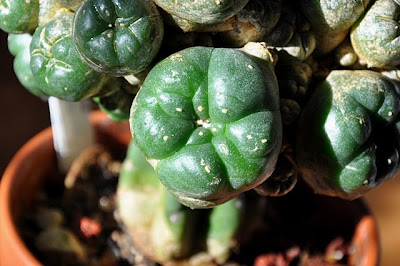
Relatively undamaged button
Large areas of the grafted Lophophora williamsii v. caespitosa are still relatively unaffected by the mites so I'm sure it will grow back given time. I'm a bit puzzled, though, why this particular plant is so popular with the mites compared to most other plants in my collection.

Top view of grafted Lophophora williamsii v. caespitosa
For comparison you can check the posts on the same plant one, two, three, and four years ago.
Tuesday, April 21, 2009
The power of grafting – 5th anniversary
Five years ago today, I grafted a tiny Lophophora williamsii (SB 854; Starr Co, Tx) seedling onto a robust Trichocereus pachanoi stock. The Lophophora scion has since grown considerably – the main head is approximately 8 cm (~3.2'') wide; the total width including the offshoots now exceeds 14 cm (~5.5'').

Lophophora williamsii grafted onto Trichocereus pachanoi stock
This growing season the plant hasn't flowered yet but one of the “pups” (new offshoot stems) will do so within days as is evident from the next picture.

Flower bud and red spider mites
Unfortunately not only the plants are returning to life after their winter hibernation – the dreaded red spider mites are also fully active again (you should be able to spot at least four mites in the photo above) so the fight is on once more.
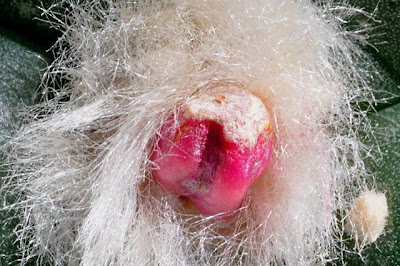
Ripe Lophophora williamsii fruit
Even though most of last year's fruits have long since ripened (and been harvested) the odd fruit is still showing. A plant this size gives hundreds of seeds each year making it a virtual seed “factory”.

Lophophora williamsii - rib count increasing?
The plant seems set on increasing its rib count beyond 8 – if I'm lucky it will not be content with growing just a few more ribs but go straight for the next number in the Fibonacci sequence, 13. The more ribs the merrier as it means more areoles and consequently more flowers and seeds.
The main head of the grafted Lophophora williamsii has grown 14 pups (15 if you also count a pup's pup – I guess you could call that a grandpup ;-) and has reached a size where it needs to be repotted soon.
For comparison you can check the posts on the same graft as one, two, three, and four years old.
Saturday, December 06, 2008
Flowering Lophophora koehresii

Flowering Lophophora koehresii; close-up
Back in August this year my grafted Lophophora diffusa var. koehresii (RS 1182; El Sabino, San Luis Potosí) flowered for the first time.
Flowering Lophophora koehresii grafted on Trichocereus pachanoi stock
Despite the difference in size of the two Lophophora diffusa var. koehresii scions in the above photo they were both started as part of the same batch of seeds March 3, 2007. The largest of the scions was grafted June 7, 2007 and when the Trichocereus pachanoi stock grew an offset I grafted another seedling on it May 5, 2008.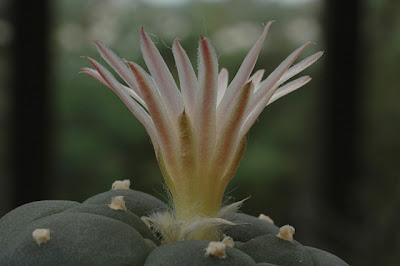
Flowering Lophophora koehresii (RS 1182; El Sabino, San Luis Potosí)
Lophophora diffusa var. koehresii is described as being of smaller size than the other Lophophora species (possibly with the exception of the newly described Lophophora alberto-vojtechii), and having a dark green epidermis and pinkish-white flowers with a light brownish mid stripe. The flower and epidermis of my plant fit the description while it might be difficult to say anything useful about size as the plant is grafted. As mentioned above the plant is still very young but I'll watch it closely as it matures.
Sunday, June 15, 2008
Lophophora williamsii v. caespitosa graft – 4th anniversary
June 7 my grafted Lophophora williamsii v. caespitosa plant could celebrate its 4th anniversary on top of its Trichocereus bridgesii stock. After four years the main head has grown to a width of 6 cm (~2.4'') and the scion is more than 14 cm (>5.5'') wide in total.

Lophophora williamsii v. caespitosa grafted on Trichocereus stock
Unfortunately the plant was maimed by spider mites last year. I didn't check my plants for mites before leaving them unattended for several weeks during my summer holiday. When I returned the damage was done and much of the plant ended up severely scarred.

Spider mite damage with new growth
Fortunately the spider mites stayed off most of my other plants, and the scarred epidermis of the grafted Lophophora williamsii v. caespitosa will soon be replaced by new growth.
To avoid spider mites I'm now showering my plants as often as the weather and my patience permit ;-) Any remaining mites are sprayed with isopropyl alcohol on sight. So far this treatment has kept my plants safe from mites, but the big test will be the coming hot summer months where the plants are left on their own to a great extent.

Lophophora caespitosa scarred by spider mites
As always I’m fascinated with the explosive growth induced by the Trichocereus stock – for comparison you can check the posts on the same plant one, two, and three years ago.
Monday, April 21, 2008
The power of grafting – 4th anniversary
Four years ago today, I grafted a tiny Lophophora williamsii (SB 854; Starr Co, Tx) seedling onto a robust Trichocereus pachanoi stock. The Lophophora scion has since grown to a width of 8 cm (~3.2'') and set 6 offshoots - the total width including the offshoots exceeds 13 cm (~5.1'').

Grafted Lophophora williamsii (SB 854; Starr Co, Tx)
The plant flowered throughout summer last year and many of the resulting seed pods are ready to be harvested. This season's first flower already appeared last week and the remains can be seen in the photo below.
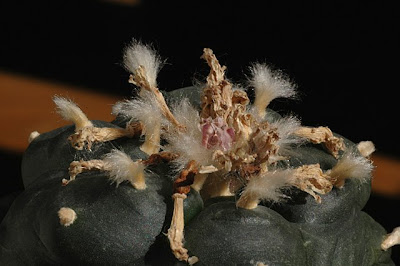
Lophophora williamsii - ready for seed harvest
Last year's flowers were allowed to self-pollinate with minimal human intervention. Today I harvested all freely exposed fruits and left the rest to fully mature. So far the result seems good as the plant set a lot of seed, time will show if it is viable.

Dried Lophophora williamsii fruit
Many of the fruits have a dry and brittle husk that is easily ripped and some of them almost spilled open when harvested. I probably ought to harvest the seeds sooner and not allow the fruits to sit and dry on the plant for too long.

Ripped Lophophora williamsii fruit with seeds exposed
As mentioned the plant has set lots of (selfed) seeds: the initial harvest totalled 101 seeds and there are still a few fruits left on the plant to be harvested later.

101 home grown Lophophora williamsii seeds
For comparison you can check the posts on the same graft as one, two, and three years old.
Monday, June 25, 2007
Lophophora williamsii v. caespitosa graft
I’ve been pretty busy lately and completely forgot to post on the 3rd anniversary (June 7) of my Lophophora williamsii v. caespitosa graft. The main head is 5.5 cm (~2.2'') wide and the total width of the scion has increased to approximately 13 cm (~5.1'').

Lophophora williamsii v. caespitosa graft
The Lophophora williamsii v. caespitosa scion is grafted on a Trichocereus bridgesii stock and was repotted early this spring (hence the supporting props).

Lophophora williamsii v. caespitosa graft - top view
I’m fascinated by the explosive growth induced by the Trichocereus stock (for comparison you can check the posts on the same plant one and two years ago) but the appearance of the plant tends to become increasingly freakish.
The plant doesn’t bloom with the same vigor as it grows – until now it’s only flowered once.
Saturday, April 21, 2007
The power of grafting – 3rd anniversary
Today one of my Lophophora williamsii (SB 854; Starr Co, Tx) plants is celebrating its 3rd anniversary as a scion grafted onto a Trichocereus pachanoi stock. The plant has set 4 offshoots and grown to a width of 7.3 cm (~2.9''), 3 of the offshoots are wider than 4 cm (~1.6'') while the smallest just exceeds 2.5 cm (~1'').
_20070421.jpg)
Grafted Lophophora williamsii (SB 854; Starr Co, Tx)
The plant set 9 flowers last year and has already displayed two flowers this year. The dried fruits resulting from last season’s flowers are clearly visible in the above photo along with the withered remains of the two “fresh” flowers from this week. The photo below was taken a couple of days ago while the flowers were still at their peak.
_20070421.jpg)
Two early Lophophora williamsii flowers
Usually I assist the plant with its self-pollination but this season I will not interfere. I’m doing this to test to which degree the plant will be able to set seed without any help – of course I can’t do anything about the thigmotropic reactions of the stamens or insects taking liberties with the flowers ;-)
A couple of days ago a flower bud also appeared on the largest of the offshoots and it will probably bloom within a week; unfortunately I will not be home to witness it. If all the offshoots begin to flower and the main shoot continues to flower in its usual pace, I’ll soon grow more seeds than I’ll ever need.
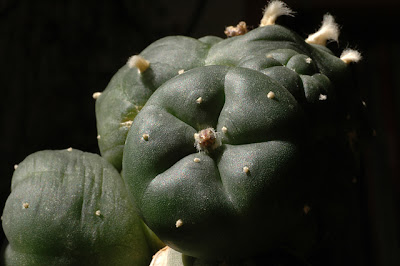
Offshoot setting a flower
Since last summer the Trichocereus pachanoi stock has also been allowed to grow an offshoot. Usually I remove these from stock plants in order not to starve the scion, but this one appeared almost at soil level and I decided to let it grow and later graft one of last years Lophophora williamsii (SB 854; Starr Co, Tx) seedlings onto it (these seedlings are the result of self-pollinating the above plant, i.e. technically they are clones of the mother plant). I had planned to do the graft today, but I’ll leave for the Netherlands tomorrow and decided to postpone doing the graft till I’m back.

Trichocereus pachanoi stock with offshoot
I was in doubt whether or not to include the last photo but decided to do it anyway. I’m fascinated by the dreamy image of the flowers backlit by the soft light of the setting sun, filtered through the foliage of a sprawling Bowiea volubilis. My girlfriend finds the picture boring and “too green” – but who is she to trust, she’s not into cacti ;-)

Flowers backlit by the setting sun
For comparison you can check the posts on the same graft written one and two years ago.
Update - April 28, 2007
Fortunately I made it home from the Netherlands in time to experience the pup unfold its first flower. The flower is not as sturdy as those of the main shoot, but what’s to expect from a novice ;-)

Flowering Lophophora williamsii pup
Today I also removed the dried fruits of last season’s flowers and freed the seeds.

9 dried Lophophora williamsii fruits

Close-up of dried Lophophora williamsii fruit
The result of the harvest was approximately 100 seeds.

Home grown Lophophora williamsii seeds
Saturday, September 30, 2006
Lophophora williamsii – autumn flowers
Having passed the autumnal equinox I hadn’t expected any more flowers from my lophs – nevertheless two of them decided to bloom this week, one for the first time.
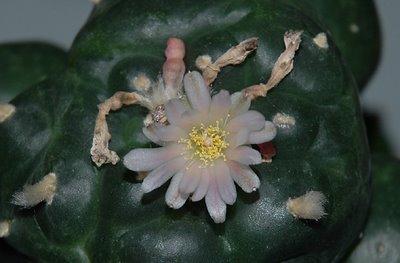
Lophophora williamsii (SB 854; Starr Co, Tx) flower
My grafted Lophophora williamsii (SB 854; Starr Co, Tx) has been flowering abundantly all summer. Several fruits have already ripened and more are budding; still the plant took the opportunity to squeeze in yet another flower before going dormant. The flowers of this plant are quite large, approximately 2.75cm (~1.1'') in diameter.

Lophophora williamsii var. caespitosa flower
The Lophophora williamsii var. caespitosa graft has been growing profusely but never felt like flowering before now. The flowers are small, less than 2cm (~0.8'') in diameter, compared to those of L. williamsii (SB 854; Starr Co, Tx), and the midstripes are a slightly darker shade of pink.

Lophophora williamsii var. caespitosa
The scion used for this graft was taken from the plant shown in the blog profile. Unfortunately this plant later caught rot and died.
Thursday, August 24, 2006
Flowering Lophophora williamsii – III
My Lophophora williamsii (SB 854; Starr Co, Tx) graft has gone on a flowering spree and is currently flashing its 7th and 8th flower this season.
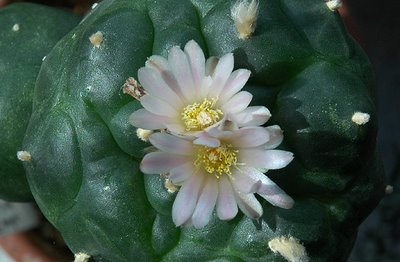
Flowering Lophophora williamsii
Like other species of Lophophora, L. williamsii has sensitive stamens, closing around the style when touched.
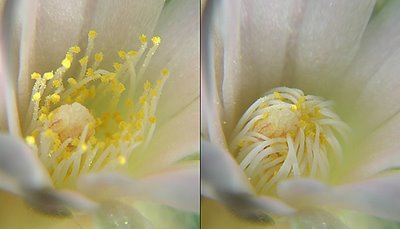
L. williamsii stamens closing around the style
In this flower the anthers are actually brushing the stigmas when the stamens react to a touch, i.e. the thigmotropic reaction will assist the flower to self-pollinate. I have to test if this is sufficient to pollinate the flower (in a previous post I also wondered if it was necessary to manually self-pollinate the Lophophora williamsii (SB 854; Starr Co, Tx) flowers or if they could cope without any help ;-)
For comparison you can check a photo of thigmotropic behavior in Lophopohora jourdaniana. In this case the stamens fold in below the stigmas, apparently not touching them.
The fruits (or berries, pods, whatever;-) from the plants first two flowers this season have just appeared.
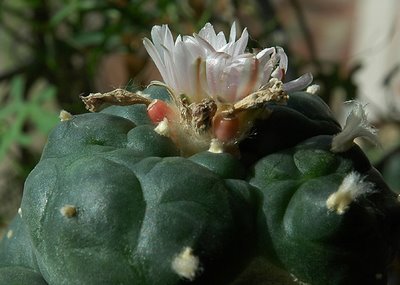
Lophophora williamsii fruits
I’m looking forward to see how many of the flowers will actually result in a fruit.
< previous |
All Time Most Popular Posts
-
Lophophora williamsii (peyote) populations have diminished in large areas of South Texas where peyoteros harvest the cactus for ceremonial ...
-
On various occasions I've been asked what growing media I'm using for my cactus plants. I don't have a set soil mix recipe as su...
-
Below is a list of retailers/nurseries selling cactus seed and plants. I've only listed vendors I've done business with. If you ar...
-
Most cacti are easily grown from seed - and with a little patience and care they can be grown into beautiful plants. Lophophora williamsi...
-
In last month’s post on the troubled Texan peyoteros I referred to Anderson’s article on the peyote situation in Texas. Given the importanc...
-
Yet another slightly off topic and probably not entirely politically correct post, but I couldn’t help noticing the similarity of my monstr...
-
Flowering stand of San Pedro cacti (Trichocereus pachanoi) To me the main draw of the San Pedro cactus ( Trichocereus pachanoi (syn. Ech...
-
In the June 2008 issue of the Cactus & Co magazine Jaroslav Šnicer, Jaroslav Bohata, and Vojtěch Myšák described a new Lophophora spec...
-
There seems to be an increased focus on the alarming Texas peyote situation. A couple of weeks ago the Houston Press published a mournful, i...
-
I spent two weeks working in Delhi, India during January. I had one weekend off and had planned to spend it in Delhi at my own leisure, but ...


















